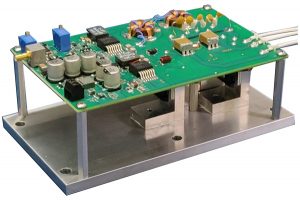Analog Modules, Inc. announces the release of its High Repetition Rate Pockels Cell Driver and High Voltage Power Supply
Longwood, FL – April 21, 2020. Analog Modules, Inc. is pleased to announce the release of its High Repetition Rate Pockels Cell Driver, Model 8212A-1 and compatible Dual Output, Dual Polarity High Voltage Power Supply, Model 533.
The Model 8212A-1 Pockels Cell/Shutter Driver is designed for high repetition rate, pulsed applications. The Model 8212A-1 has a variable pulse width output with rise and fall times of less than 7 ns at output voltages up to 2.0 kV. Repetition rates up to 50 kHz with no additional cooling and burst operation up to 2 MHz is possible with appropriate cooling.
The Model 533 Dual Output, Dual Polarity High Voltage Power Supply is ideally suited for  providing the required high voltage for the Model 8212A-1. The Model 533 has a differential output voltage of up to ±1 kV. Maximum power output is 125 W with up to 90% efficiency in a compact, OEM form factor.
providing the required high voltage for the Model 8212A-1. The Model 533 has a differential output voltage of up to ±1 kV. Maximum power output is 125 W with up to 90% efficiency in a compact, OEM form factor.
For detailed specifications and outline drawings on the Model 8212A-1 and Model 533, visit our website to view the product data sheets. You may also contact AMI to discuss the specifics of your application at sales@analogmodules.com or phone +1 407-339-4355.
**********************************************************************************************************
For further information, contact:
Kelly Pacy, V.P. Sales (321-527-3603) sales@analogmodules.com or
Tim Cable, Product Manager (321-527-3613) tcable@analogmodules.com

 sales@analogmodules.com
sales@analogmodules.com 1-407-339-4355
1-407-339-4355

 Hybrid eyesafe laser rangefinder receiver is designed for laser rangefinding & surveying equipment. Compact construction is ideal for miniature applications. Fast recovery from T0 overload allows ranging to close objects without compromising long range performance. The incorporation of an InGaAs APD gives very high sensitivity with time programmed gain to minimize false targets. Operation at both 1.06 µm and 1.54 µm is possible over a wide range of pulse widths.
Hybrid eyesafe laser rangefinder receiver is designed for laser rangefinding & surveying equipment. Compact construction is ideal for miniature applications. Fast recovery from T0 overload allows ranging to close objects without compromising long range performance. The incorporation of an InGaAs APD gives very high sensitivity with time programmed gain to minimize false targets. Operation at both 1.06 µm and 1.54 µm is possible over a wide range of pulse widths.
